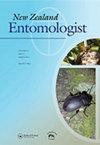Seasonal patterns of drosophilid flies and parasitoid wasps attracted to rotting fruit and vegetable baits in Canterbury, New Zealand
IF 0.6
4区 农林科学
Q4 ENTOMOLOGY
引用次数: 1
Abstract
ABSTRACT Although Drosophilidae and associated hymenopterous parasitoids have been the subject of much field and laboratory ecology in many parts of the world, the system has been relatively neglected in New Zealand. This study investigated the seasonality of Drosophila, Scaptodrosophila and associated hymenopterous parasitoids in Canterbury by using traps baited with banana, orange, mushrooms, other fruits and vegetables and vinegar at two locations, New Brighton and Lincoln. From 176 sampling events, seven species of drosophilid were collected: Drosophila busckii; D. funebris; D. hydei; D. immigrans; D. pseudoobscura; D. simulans; and Scaptodrosophila enigma. Seven species of adult parasitoid wasps were also recorded in the traps: the braconids Dinotrema longworthi, Aphaereta aotea, Asobara tabida, Aspilota andyaustini; the ichneumonid Campoplex sp.; and two encyrtids, including Tachinaephagus zealandicus. The more abundant drosophilid species were found throughout the year, with fewer species occurring in the winter months (June–August). Parasitoids tended to be found more often in the warmer months, with only one specimen (of Aspilota andyaustini) collected between June and October. All seven species of drosophilids were obtained from traps with banana and mushroom baits. Mushroom proved valuable for obtaining parasitoids, with five species being recorded on this bait. Although the wasps were all captured along with adult Drosophila, it is believed only one species, Asobara tabida, is a confirmed drosophilid parasitoid. Further field study, on a wider geographic scale, in natural and modified habitats, is required to provide additional information on the phenology, biogeography and parasitoid–host interactions of drosophilids in New Zealand.新西兰坎特伯雷,果蝇和寄生蜂被腐烂的水果和蔬菜诱饵吸引的季节模式
虽然果蝇科及其相关的膜翅类寄生蜂在世界许多地方已经成为许多野外和实验室生态学的主题,但该系统在新西兰相对被忽视。本研究在坎特伯雷新布赖顿和林肯两个地点,采用香蕉、橘子、蘑菇等水果和蔬菜和醋为诱饵,对果蝇、鳞翅目果蝇及其相关的膜翅类寄生蜂进行了季节性调查。从176个采样事件中,收集到7种果蝇:布氏果蝇;d . funebris;d . hydei;d . immigrans;d . pseudoobscura;d . simulans;和谜形Scaptodrosophila enigma捕集器中还捕获了7种拟寄生蜂,分别是:长角小蜂、大角小蜂、小角小蜂、小角小蜂;类肺炎菌群;和2种通虫,包括新西兰速虫。全年果蝇种类丰富,冬季(6 ~ 8月)较少。拟寄生物往往在较温暖的月份被发现,在6月至10月期间只收集到一个样本(Aspilota andyaustini)。7种果蝇均由香蕉和蘑菇诱捕器捕获。事实证明,蘑菇对获取拟寄生虫很有价值,在这种诱饵上记录了5种。虽然这些黄蜂都是和成年果蝇一起被捕获的,但据信只有一种被证实是果蝇的寄生物种,即Asobara tabida。需要在更广泛的地理范围内,在自然和改良生境中进行进一步的实地研究,以提供有关新西兰果蝇物候学、生物地理学和寄主-寄主相互作用的更多信息。
本文章由计算机程序翻译,如有差异,请以英文原文为准。
求助全文
约1分钟内获得全文
求助全文
来源期刊

New Zealand Entomologist
ENTOMOLOGY-
CiteScore
0.70
自引率
33.30%
发文量
3
审稿时长
>12 weeks
期刊介绍:
The invertebrate diversity of New Zealand is of great interest worldwide because of its geographic isolation and geological history. The New Zealand Entomologist plays an important role in disseminating information on field-based, experimental, and theoretical research.
The New Zealand Entomologist publishes original research papers, review papers and short communications. We welcome submissions in all aspects of science regarding insects and arthropods in a New Zealand or Australasian setting. The journal’s subject matter encompasses taxonomy, phylogenetics, biogeography, biological control and pest management, conservation, ecology and natural history.
The journal is the official publication of the Entomological Society of New Zealand. Papers published or submitted elsewhere for publication will not be considered, but publication of an abstract or summary elsewhere (e.g. conference proceedings) does not preclude full publication in the New Zealand Entomologist. Accepted papers become copyright of the Entomological Society of New Zealand. The journal is published in English, but we also welcome publication of abstracts in Maori.
 求助内容:
求助内容: 应助结果提醒方式:
应助结果提醒方式:


